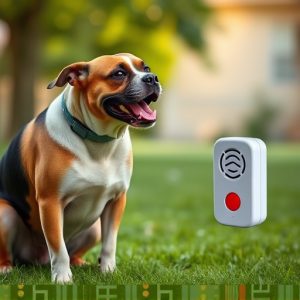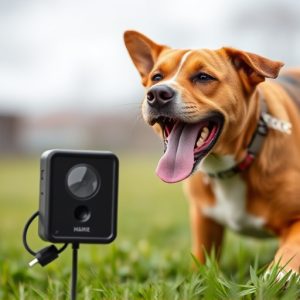Ultrasonic Dog Repellents: Safety, Training, and Choosing the Right Device
Sonic deterrents offer a humane, non-toxic solution to keep dogs away from specific outdoor areas, u…….
Sonic deterrents offer a humane, non-toxic solution to keep dogs away from specific outdoor areas, using high-frequency sound waves (23-64 kHz) that are unpleasant to dogs but inaudible to humans. With a coverage range of 50-100 feet, they're ideal for walkways, gardens, or patios. These devices condition dogs to avoid treated areas, deterring behaviors like barking, defecation, or urine marking. They provide a safe and effective method for walks, addressing aggression or anxiety in encounters. Choose adjustable models that mimic natural sounds to avoid startling your dog, and train them to accept the device for positive walking experiences, especially in potentially hazardous areas.
“Enhance your pet walking experience with an ultrasonic dog repellent—a innovative, non-harmful solution for managing canine behavior. This comprehensive guide explores the science behind sonic deterrents and their effectiveness in repelling dogs without distress. We’ll delve into the advantages of integrating these devices into your routine, offering tips on selection and training to ensure a safe, positive experience. Discover how an ultrasonic dog repellent can create a peaceful, controlled environment for both you and your pet while exploring the ideal sonic deterrent range for optimal results.”
- Understanding Sonic Deterrents: How They Work for Dog Repellency
- Benefits of Using a Ultrasonic Dog Repellent While Walking Your Pet
- Choosing the Right Sonic Deterrent for Your Dog's Safety and Comfort
- Training Your Dog to Accept and Respond Positively to Ultrasonic Repellents
Understanding Sonic Deterrents: How They Work for Dog Repellency
Sonic deterrents are a non-toxic, humane way to keep dogs away from specific areas while walking or spending time outdoors. They work by emitting high-frequency sound waves that are unpleasant for dogs but virtually inaudible to humans. This technology leverages a dog’s sensitive hearing and natural aversion to certain sounds to create a safe barrier without causing any harm.
The sonic deterrent range for dogs typically covers an area of about 50 to 100 feet (depending on the model), making it ideal for walkways, gardens, or patios. When activated, these devices emit ultrasonic frequencies that fluctuate between 23 and 64 kHz, which are known to disturb dogs without disturbing other animals or humans. The consistent presence of these sounds conditions dogs to avoid the treated area, effectively deterring unwanted behavior like barking, defecation, or urine marking.
Benefits of Using a Ultrasonic Dog Repellent While Walking Your Pet
Using an ultrasonic dog repellent while walking your pet offers numerous benefits, especially in terms of maintaining a safe and enjoyable experience for both you and your four-legged companion. These devices emit high-frequency sound waves that are unpleasant to dogs but harmless to humans and other pets. This non-toxic approach is a game-changer when it comes to managing aggressive or anxious dogs you might encounter on walks.
The sonic deterrent range for dogs can extend up to several metres, allowing you to keep your pet at a safe distance from potential triggers or hazards. It’s an effective tool for training purposes too; by consistently using the repellent during walks, you can help teach your dog to avoid certain areas or behaviours, enhancing their overall behaviour and walk manners.
Choosing the Right Sonic Deterrent for Your Dog's Safety and Comfort
When selecting a sonic deterrent for your dog, it’s crucial to consider both their safety and comfort. These devices use high-frequency sound waves to deter dogs from specific areas, but not all models are created equal. Look for a sonic deterrent range for dogs that offers adjustable frequency settings to customize the intensity based on your pet’s sensitivity. Some dogs might be more bothered by higher frequencies, so the ability to adjust ensures a more comfortable experience without compromising effectiveness.
Additionally, consider the type of noise generated. While some devices emit consistent sounds, others use quick pulses or patterns. Choose a model that produces sounds similar to everyday ambient noises, like birds chirping or children playing, to minimize startling your dog. Regular testing and adjustments will help find the perfect balance, ensuring your dog remains safe and at ease during walks.
Training Your Dog to Accept and Respond Positively to Ultrasonic Repellents
Training your dog to accept and respond positively to ultrasonic repellents is a crucial step in ensuring safe walking experiences, especially when navigating areas with potential hazards or unwanted encounters. These devices emit high-frequency sound waves that are harmless to dogs but effectively deter them from certain behaviors or locations. To teach your dog to cooperate, start by familiarizing it with the device while it’s switched off, allowing your pet to get used to the sound and associate it with positive experiences, such as treats or praise.
Gradually introduce the repellent in a controlled environment, activating it at safe distances and rewarding calm behavior. Gradually decrease the distance over time as your dog becomes accustomed to the sound. It’s important to note that consistency is key; regular training sessions will help reinforce the association between the ultrasonic deterrent range for dogs and positive outcomes, making walks safer and more enjoyable for both you and your pet.
Ultrasonic dog repellents offer a safe, effective solution for keeping dogs away from potential hazards while walking. By understanding how these devices work and choosing the right model for your pet’s needs, you can ensure a more enjoyable and secure outdoor experience. Training your dog to accept the ultrasonic signal further enhances their comfort and responsiveness, making it an excellent addition to any pet owner’s toolkit for managing their canine companion’s behavior during walks in diverse environments.


